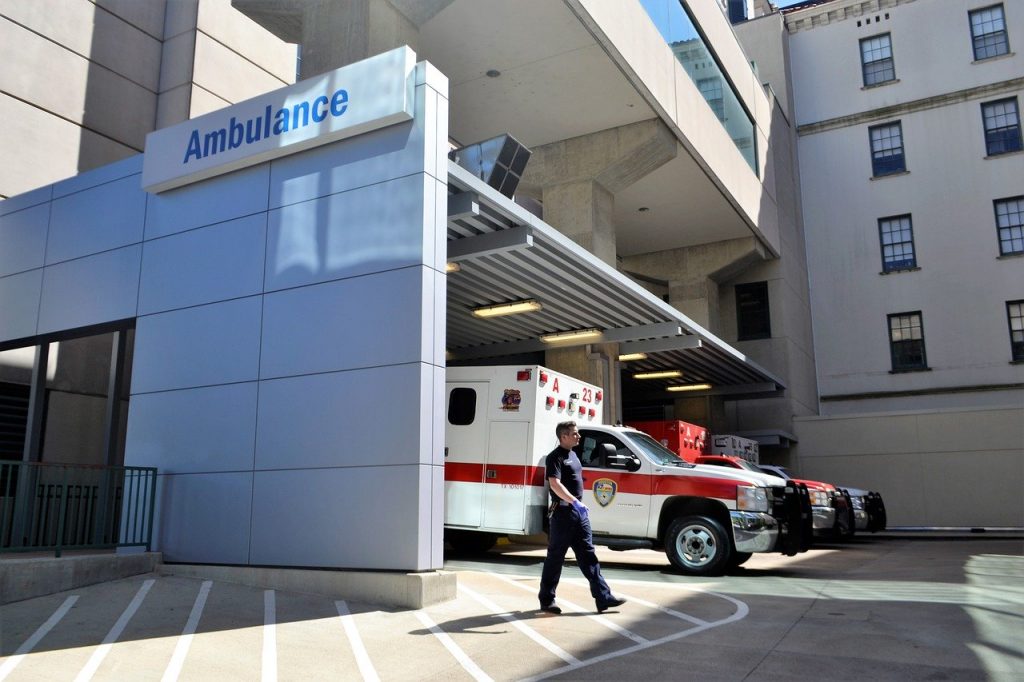The following article features the details about the job of an EMT, including their duties, training and qualifications, skills, and more.
We will also go through the working hours and career opportunities that come with the position.
And EMT stands for Emergency Medical Technician who is the first responder to emergencies.
They provide non-invasive basic care in such situations as violent crimes, car accidents, etc.
After providing first aid and stabilizing the patient with the help of other first responders, such as firefighters, police officers, and paramedics, EMT transport them to the hospital.
Article Table of Contents
What Does an EMT Do
Emergency medical technicians are dispatched to emergencies through 9-1-1.
Usually, they work alongside paramedics and firefighters to provide basic care to ill or injured people.
Since emergencies can happen at any time, an EMT works at any time of the day or night, as well as on weekends and holidays, depending on what their schedule is.
With a fast-paced and stressful work environment, EMTs have a median salary of $32,670 per year.
Responsibilities
- Arrive at the emergency sites and transport patients to the hospitals.
- Assess the situation and call for backup if needed.
- Create the environment safe for bystanders or traffic if needed.
- Determine which patient’s or patients’ conditions are critical and call for care first.
- Provide first aid and emergency care when necessary.
- Safely place patients on stretches and secure them in the ambulance.
- Provide medical care on the way to the hospital as needed.
- Communicate with the medical facility regarding the patient’s injuries and medical needs.
Essential Skills
Stress tolerance:
An EMT can be exposed to car accidents, violent crimes, and other scenes regularly, so they need to respond well in a stressful situation.
They have to be able to maintain their mental health.
Quick thinking:
EMTs have to make decisions quickly and under huge pressure.
Decisions should be correct and confident since they are made in life-or-death situations.
Detail-oriented:
When evaluating the condition of a patient, EMTs need to notice any signs of serious injury or illnesses, maintain accurate records, and apply medications with the right dosage.
Communication:
An EMT should communicate with hospitals, dispatchers, coworkers, as well as distraught patients and bystanders.
Communication skills are important to convey the right medical information and help others stay calm.
How to Become an EMT
Aspiring EMTs need a high school diploma or GED together with completed training specific to the job.
Upon completion of training, they need to pass a written and practical examination to get a certification.
More detailed information on qualifications, training, and experience is listed below.
Training and Qualifications
An EMT is an entry-level job, so only a high school diploma or equivalent (GED) is necessary for the candidates.
However, additionally to that, prospective candidates have to complete EMT training.
It comes in three levels:
Level 1/EMT Basic
This is the first level to complete before a person can work as an EMT and before they move on to other levels.
At this point, candidates learn basic first aid such as stopping bleeding, setting broken bones, dealing with respiratory and cardiac emergencies.
The training on this level will include clinical labs and fieldwork.
Upon completion of 120 to 180 hours of training, candidates should pass a written and practical state-certified exam.
They will get a certification of an EMT-B.
Usually, it takes about 6 months to complete the entire level.
Level 2/EMT Intermediate
This level comes after the completion of the Basic one, and it includes an extra 30 to 350 hours of training.
Candidates learn how to use more advanced medical equipment and how to administer medications and intravenous fluids.
Level 3/Paramedic
A paramedic is the highest level an EMT can reach.
Paramedics are typically trained at community colleges.
The degree lasts for 2 years.
The training and examinations are more advanced and definite and include 1,200 to 1,800 hours of training.
After the training is completed, a candidate will have to pass a state licensing examination.
Qualifications and certifications for EMTs or paramedics vary in every state.
Work Experience
Starting a job as an EMT doesn’t require work experience.
The training that candidates undergo provides enough experience to start a job.
However, having some experience with emergency-type situations can be beneficial.
One of the most essential qualifications for an EMT is the ability to stay calm and make the right decisions in stressful situations.
See the full guide: How to Become an EMT/Paramedic
Working Hours
The position of an EMT is typically full-time featuring 40+ hours a week.
Although the week may last longer than 40 hours, more than 50 hours per week aren’t that common.
If you are looking for a 9-to-5 job, the position of an EMT won’t be the best fit.
Since emergencies are unpredictable and can happen at any time, EMTs work various shifts, including overnight, weekends, and holidays.
Shifts last from 12 to 24 hours.
Usually, EMTs work set shifts on specific days, with a specific number of shifts per week.
Career Outlook
Even EMTs of lower level make a decent salary, around $32,000 or more, depending on experience.
Paramedics can earn over $70,000.
In terms of finances, this is a great job.
With high stress and constant traumatic events, EMTs are prone to burnouts.
With the long hours on the job, it can be hard balancing work and personal life.
EMTs should be certain they can handle this job both emotionally and personally.
The job outlook for the profession is positive.
There is always a need for emergency services.
Also, with an aging population of baby boomers, the demand only continues to grow.
With the three levels of EMTs, they always have room for advancement, from basic, to intermediate, and to a paramedic.
If paramedic EMTs wish to advance even further, they can become administrative directors, managers, or teachers.
Many EMTs also use this position to later advance to higher medical professions, such as nurses, physician assistants, and doctors.
Conclusion
The job of an EMT is for those who can withstand stress and balance life and work, but it’s a highly rewarding profession.
EMTs can help people while having multiple advancement opportunities and receiving a decent salary.
So the benefits on the job may outweigh the stress and difficulties involved.

